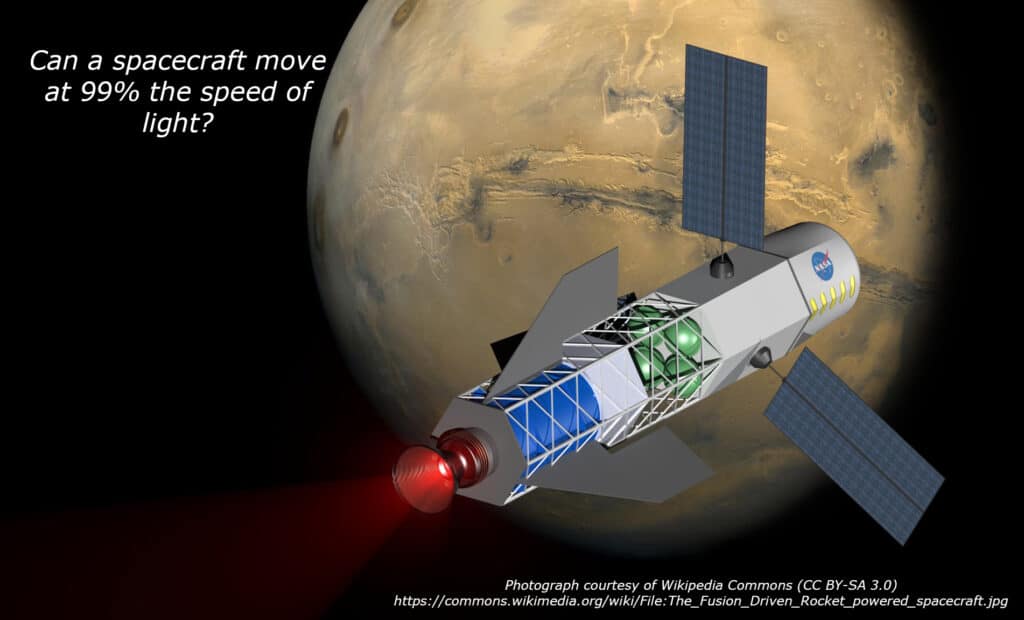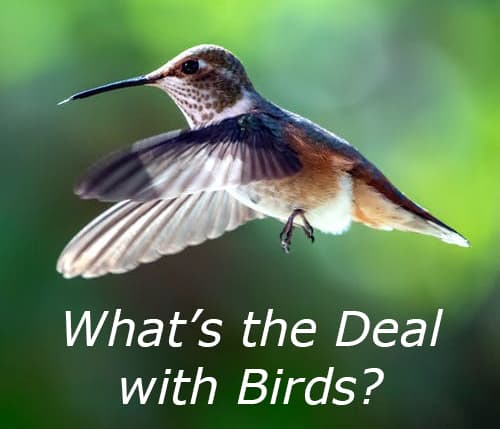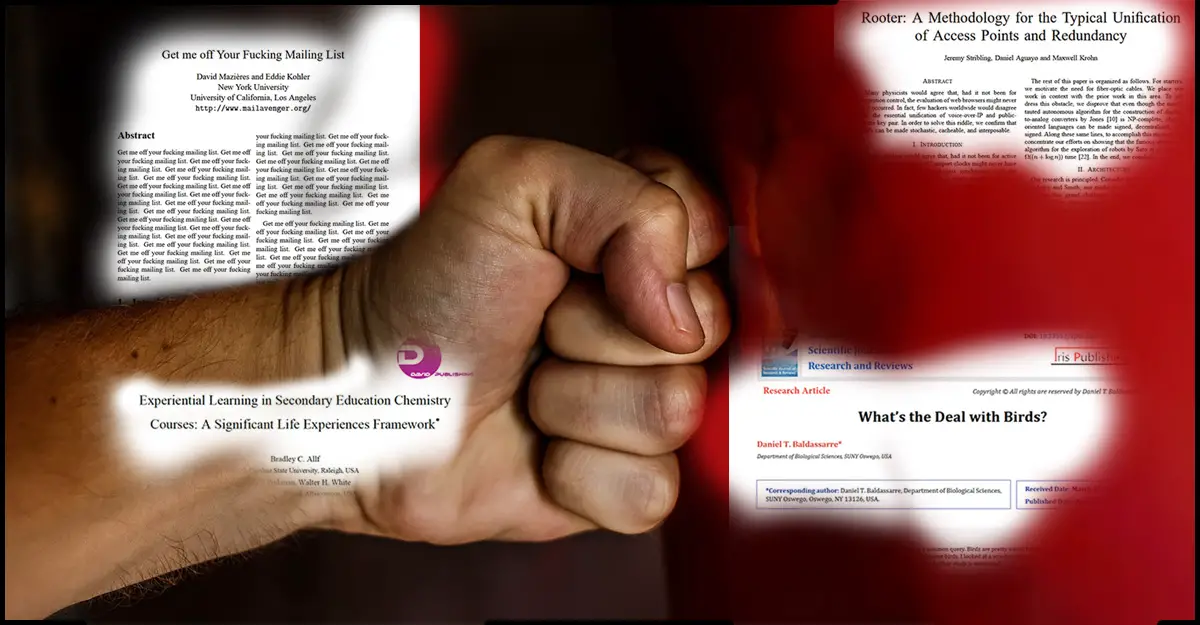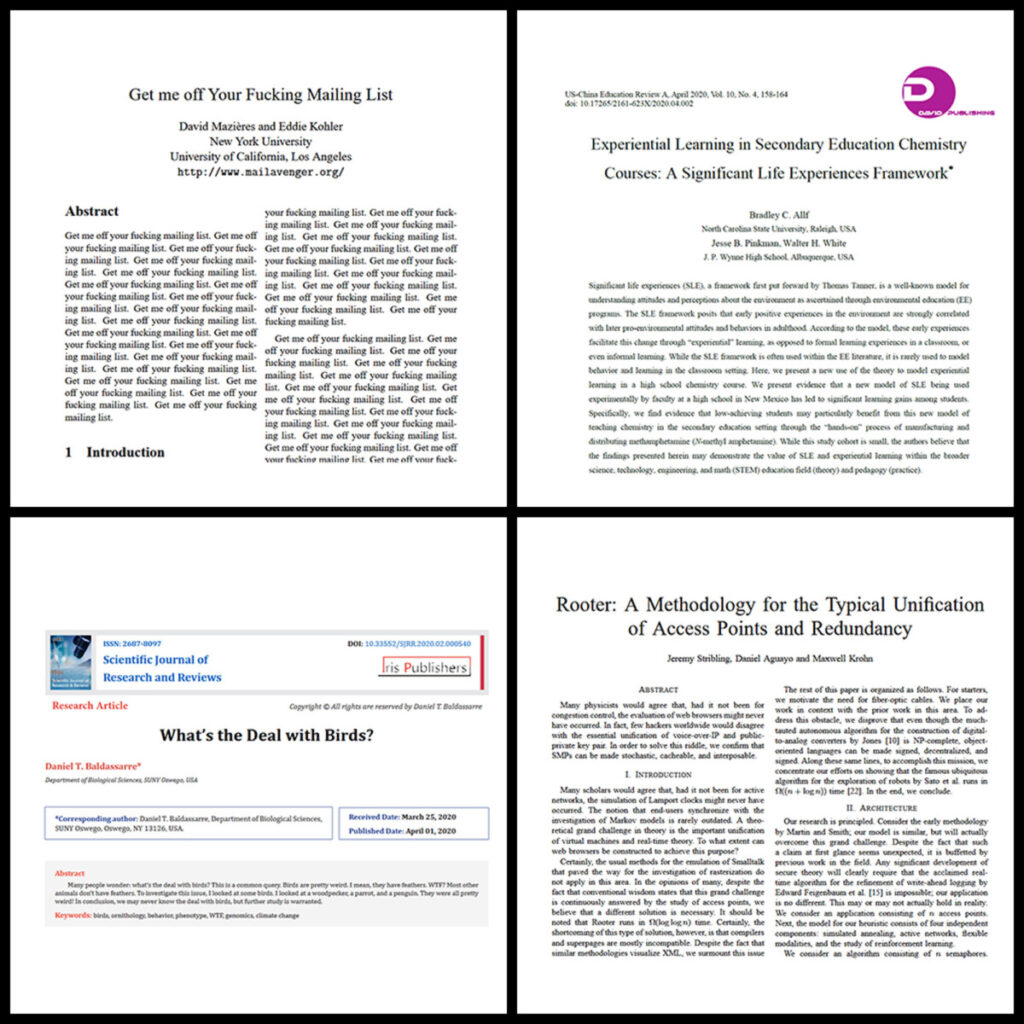In order to demonstrate that a given journal is predatory, some people have staged sting operations. That is, they submit a nonsense paper to see if it gets through the peer review, or whether these is any peer review at all.
In this article we look at a few papers that were submitted to test journals, whether these were submitted but never made it to publication, or whether the paper was actually published.
We also take the opportunity to look at a paper that we felt could have been a sting paper but, we suspect that it was submitted, and accepted, as regular paper. We just find it hard to believe that the paper went through rigorous peer review.
Sting operations
To show the danger of predatory publishing and to demonstrate the lack of peer review, there have been a number of sting operations.
Get me off your f@#&ing mailing list
Perhaps the most famous, certainly the one with the most evocative title, is a paper that was submitted with the title “Get me off Your F@#&ing Mailing List” and which just repeated this phrase hundreds of times in the body of the paper. The paper was submitted to the International Journal of Advanced Computer Technology, which accepted it and then demanded USD 150 to publish it.
We have published a previous article, which focuses on this particular sting. If we are honest, it is probably our favorite sting, not only because it uses rude words, but also because it is so obviously nonsense and any cursory glance, let alone peer review, would have spotted this.
SCIgen
Not a sting in its own right, but there are ways that you can generate scientific papers. They will be nonsense, but could get past an editor who does nothing else other than glance at the paper. SCIgen is probably the most famous. This tool generates random Computer Science papers and, if you try it, it does produce gobbledegook, but it looks convincing at first sight. We plan to write a more detailed blog post about the automatic generation of papers but, if you want to give SciGen a try, take a look their at their website.
You can see one of their generated papers here.
Who's afraid of peer review?
If you want a viewpoint, that is more scientific in nature, about a sting operation aimed at a predatory publisher, we would suggest you take a look at the following paper.
- Bohannon J. (2013) Who’s Afraid of Peer Review? Science, 04 Oct 2013. DOI: 10.1126/science.342.6154.60
The paper starts by saying:
“On 4 July, good news arrived in the inbox of Ocorrafoo Cobange, a biologist at the Wassee Institute of Medicine in Asmara. It was the official letter of acceptance for a paper he had submitted 2 months earlier to the Journal of Natural Pharmaceuticals, describing the anticancer properties of a chemical that Ocorrafoo Cobange had extracted from a lichen.
In fact, it should have been promptly rejected. Any reviewer with more than a high-school knowledge of chemistry and the ability to understand a basic data plot should have spotted the paper’s shortcomings immediately. Its experiments are so hopelessly fl awed that the results are meaningless.
I know because I wrote the paper.“
John Bohannon goes on to say that he submitted 304 versions of that paper to open access journals, with more than half of those journals accepting the paper.
The journal that accepted the paper (Journal of Natural Pharmaceuticals) was published by Medknow, which publish more than 270 journals, as noted in Bohannon’s paper. Looking at the Medknow web site now (accessed, 5 Sep 2020), they now state that they publish 487 journals. The journal in question does not seem to exist anymore, which agrees with the statement in Bohannon’s paper that the managing editor agreed to close the journal down.
Given that Bohannon’s paper was published in 2013, it would be unfair to make any comment about the legitimacy of the journals published by Medknow seven years on, but we have added it to the list of publishers that we would like to investigate. If you have had any experience with Medknow, please let us know via our Twitter site.
As we said above, more than half of the 304 submissions of the paper were accepted. This included acceptances by Sage and Elsevier. It is credit to PLOS ONE, one of the leading open access journals, that the paper was rejected within two weeks after checking some facts with the fictional author.
The Bohannon paper is an interesting read and contain many more details than we can cover here.
Some actually made it
It is one thing submitting a nonsense paper, which is never published (usually as the authors do not pay the Article Processing Charges), but some nonsense papers have made it to being published; and some remain there for the world to see.
Mathematical proof of the law of Karma
In an article by Jeffrey Beall (“Predatory journals exploit structural weaknesses in scholarly publishing“) he cites an article from 2014, entitled “Mathematical proof of the Law of Karma“. Talking about the publisher, Science Publishing Group (SPG), he says:
“People are being fooled into believing SPG is a legitimate publisher or they are exploiting its automatic article acceptance to get easy academic credit, or both. Many of the articles it publishes are nonsense. For many years, I’ve used the article ‘Mathematical proof of the law of karma’ as an example in lectures I’ve given, an article that always draws laughter from the audience.“
The Karma paper is still available (follow the link above), if you want to take a look at it.
We cannot comment on the quality of SPG, as the Karma paper was published six years ago, but it is another publisher on our list that we would like to take a closer look at.
What's the deal with birds
This paper, we would like to think on purpose but it was probably just a happy coincidence, was published on 1 April 2020. If you don’t know, this is known as April Fools Day.
The paper was received by Scientific Journal of Research and Reviews on 25 March 2020 and published on 1 April 2020. That is only eight days, including the day of receipt and the day of publication. Moreover, there was a weekend in there, so really only six working days between receipt and publication. In our experience, this is VERY fast and suggests that peer review was not carried out.
This view is supported by looking at the paper. The Introduction starts with this:
“Birds are very strange. Some people are like ‘whoa they’re flying around and stuff, what’s the deal with that?’ This sentiment is shared by people across socioeconomic backgrounds. Figuring out what the deal is with birds is of the utmost scientific importance.“
We would suggest that this is not the type of wording you would expect in a high quality, peer reviewed scientific paper. But the acknowledgments, in our mind, are magnificent. They say:
“We thank Big Bird from Sesame Street for comments on the manuscript. Several trained monkeys transcribed videos.“
Isn’t that brilliant? More importantly, any form of peer review would surely would have raised a smile on the reviewer’s face before rejecting the paper.
The paper is no longer available. Following the publicity it received (for example, see this article) it was withdrawn. The DOI (10.33552/SJRR.2020.02.000540) is now reported as being not available.
Fortunately, before the paper was withdrawn, we retrieved a copy and you can download it from this link.
The publisher of the journal is Iris Publishers. This is another publisher that we have put on our list to look at more closely.
Sting, Exploitative or Genuine?
There are some articles that could be a sting operation, which have made it through to publication, they could be an author that is using predatory publishers to bolster their CV or the paper could be genuine.

An article published earlier this year, and we only mention it as we were discussing it with somebody on Twitter Direct Messages, we feel sure cannot be a genuine article, but if you are an expert in space exploration, please feel free to correct us.
The article claims to have a way of moving a spacecraft at 99% of the speed of light. There are two things that worry us about this paper. The first is that if this is true, we would have expected to have seen this widely reported in the international media. None of us here are physicists, but as science aware people, we do not believe that moving at 99% of the speed of light is currently possible.
The other worry is that the paper was received on 3 July 2020, was accepted on 7 July 2020 and published on 30 July 2020. For such an important claim, we would have expected the review time to be more than four days.
As we say, we are not physicists, or space scientists, so please take a look at the paper and draw your own conclusions. The details are as follows:
D. Kamalta (2020) Move the Spacecraft at 99% Speed of light by Rotation Technique, Journal of Space Exploration, 9(2):1-3. The DOI is 10.21767/2319-9822.1000163, but when we tried to link to the article using the DOI, it did not work, but we could access the paper using this link.
The journal is published by Trade Science Inc. Another publisher we have added to our list to investigate.
Finally
In this article, we have described a number of sting operations. No doubt there are others and we would be interested in compiling a comprehensive list, so if you know of any, please let us know.
As well as sting operations, where the paper did not make it into print, some been published. They may have subsequently be withdrawn (but not always), but the fact that they got through the peer review process, all the way to being published does not look good on the journal that published the paper. If you know of any papers that were designed to illustrate the lack of peer review for a predatory journal, please share it with us, especially if they made it all the way to being published.
We also looked at one paper that looks as if it cannot be true, but we are not expert enough to make a definitive judgement. If you are an expert in space exploration, please let us know your view. We would also be interested in other papers that look like they are totally nonsense, whether they were submitted as a sting operation or for some other reason.
The research for this article drew out four publishers that are certainly worth another look, these being Medknow, Science Publishing Group (SPG), Trade Science Inc. and Iris Publishers. If you know of any other publishers that are worth us investigating, please let us know.
FURTHER READING
If you want to read more about predatory publishing, you might want to take a one of our other articles, “Read these three articles to understand predatory publishing“. The articles mentioned in that article are all open access so are available to anybody.
Many people ask, “How do you identify a predatory journal?” Another way to ask this question is “How do you identify a non-predatory journal?” To answer this question, take a look at the article that we published. If you want to know three quick ways to identify a predatory journal, take a look at this article.
Article history
Where an article has been updated since first being written, we provide a history of the changes. Why? Why not :-).
- The original article was published on 6 September 2020.
- The article was updated on 04 August 2023. We removed profanities (at least, putting in special characters) we we felt that search engines did not like it. It was actual in the title of papers, so the profanities should have remained, but we felt it better to remove them.






